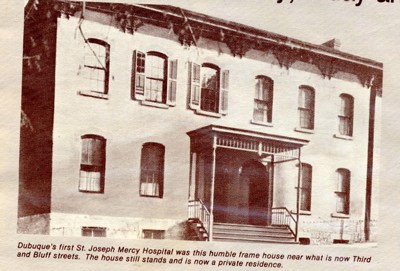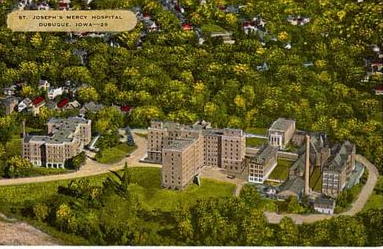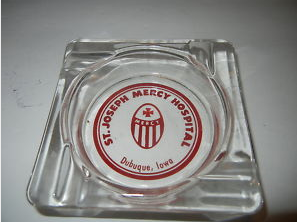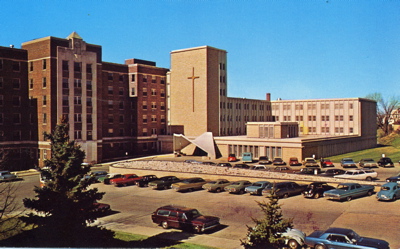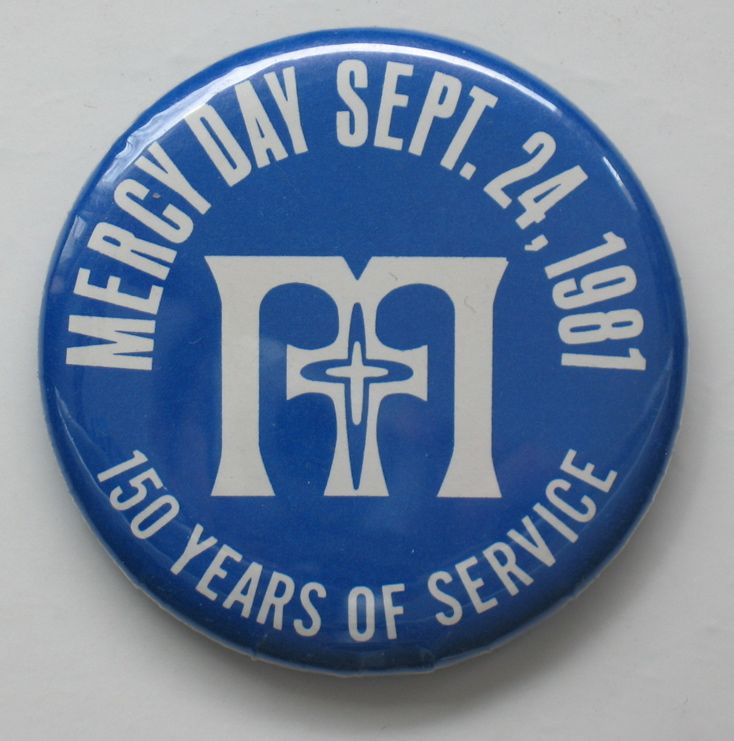Encyclopedia Dubuque
"Encyclopedia Dubuque is the online authority for all things Dubuque, written by the people who know the city best.”
Marshall Cohen—researcher and producer, CNN
Affiliated with the Local History Network of the State Historical Society of Iowa, and the Iowa Museum Association.
MERCY MEDICAL CENTER
See: JULIEN HOUSE
MERCY MEDICAL CENTER. In 1850 T. Davis offered ten acres and a house to be used as a hospital to the city council which accepted his offer. (1) This appeared to be the firsts designated hospital in the city. In 1879, at the request of Bishop John HENNESSY, Mother Mary Baptist Martin, Sister Mary Agatha Murphy and Sister Mary Euphrasia come to Dubuque to establish a hospital. (2) On January 13, they opened St. Joseph's Mercy Hospital in a house at the corner of Third Street and Bluff. (3) The facility was the second hospital established in the State of Iowa by the SISTERS OF MERCY and quickly became the largest hospital within Dubuque and Jackson counties in Iowa; Jo Daviess County, Illinois; and Grant County, Wisconsin.
Working without heat, electricity, or running water, the Sisters by April 1879 were caring for fourteen orphans and many elderly. The orphans were taught reading, writing, and arithmetic while the older children were taught to work. Housing was also provided for homeless girls looking for work. (4) A MERCY HOSPITAL AID SOCIETY was organized on November 14, 1879. In July 1880 the Dubuque Herald ran an article on the soon-to-be-opened Mercy Hospital and Orphan Asylum. (5)
The medical staff in the early days of the hospital included ten physicians and the sisters who, in addition to their attention to spiritual needs of the patients, cooked, washed, ironed, and cleaned. In 1885 the Sisters of Mercy opened ST. JOSEPH'S SANITARIUM, the first mental health provider in the area. (6)
A $25,000 surgical annex was opened in 1892 which nearly doubled its size. Although surgeries had previously been done, this annex housed the first Surgery Department. (7)
In the fall of 1900 Mercy opened its NURSING EDUCATION program with instruction including the proper methods of bed making, dusting, dressing wounds, and the application of leeches. The school was accredited by the State Board of Nurses Examiners in July of the same year. (8) Graduating its first class in 1902, the school remained open until 1974. (9)

Continued expansion included the construction of East Building, a $200,000 addition in 1905 that nearly doubled the hospital's size. This addition also housed the area's first permanent operating room and boasted an X-ray machine. This addition was thought to make Mercy the "finest hospital west of the MISSISSIPPI RIVER. (10)
ST. ANTHONY'S HOME FOR THE AGED was constructed in 1912. Located west of the hospital it was partially demolished in 1967 to allow for additional hospital expansion. The remainder of the building was torn down in 1970. The site was soon occupied by Medical Associates East Campus. (11)
The original hospital building was demolished in 1921 to make room for McAuley Hall, a convent for the Sisters. The convent, opened in 1922, remained until the early 1980s when it was demolished for the construction of the Professional Arts Plaza. (12)
In 1922 one of the largest x-ray machines in the world for the treatment of cancer was installed in St. Joseph's at a cost of $10,000. This made Dubuque the second city in Iowa (behind Davenport) to have such a machine. (13)
In 1947 the $2,500,000 expansion increased Mercy's capacity with an additional two hundred beds. (14)
In 1948 Thelma Byrne Trapp and Barbara Palen Faber presented the idea of a gift shop to promote the hospital and help children to Mercy's administrator, Sister Edmunda. The approval secured, fifty local women were invited to a luncheon to learn more about the Mercy Service Club and forty-five became charter members. The plan was to open a small gift shop in the hospital lobby and take a cart through the hospital to patients. The Mercy Service Club Gift Hospital opened on Hospital Day, May 12, 1948. (15)
The club focused efforts on helping children in need and sometimes helped a family pay a hospital bill. In the 1940s and 1950s club members worked with young polio victims by providing toys or financial support. Funds for an isolette for transporting high-risk infants to the hospital's newly opened neonatal intensive care unit were provided in the 1970s. In 1998 the club again donated a self-contained mobile infant intensive-care unit for transporting ill and premature newborns. (16)
In 1963 hospital consultants Hamilton and Associates began a study to determine the future operation of St. Joseph Mercy Hospital, St. Anthony's Home and St. Joseph Sanitarium. As a result of the study, a recommendation was made to combine the three institutions.
In 1964 the three Sisters of Mercy operated institutions in Dubuque began their merger. According to the American Hospital Association records, this was the largest merger of hospital facilities ever accomplished in the United States to that time. The merger made possible the replacement of out-of-date facilities at Mercy Hospital and St. Joseph Sanitorium. The new $8.5 million building included one of the first Comprehensive Mental Health Centers in the United States to be established under Public Law 88-164. The $2 million in mental health funds and the $1 million dollars in Hill Burton general hospital construction funds fro the federal government represented one of the largest mental heal grants ever awarded and the largest combined grant ever given in Iowa. The same year, Mercy helped form the first planning council in Iowa with the organization of the Dubuque Area Health Facilities Planning Board. (17)
In March, 1967 the combined facilities were officially changed to Mercy Health Center. In December of that year, construction began on Dubuque's first intensive care unit. (18)
Dubuque's first hospital based Social Services Department opened in April, 1968. The first Baby Sitting School in Dubuque taught by Mercy nurses with the cooperation of the police and fire departments registered 316 youth in May. Dubuque's first hospital based respiratory therapy department in Dubuque was opened at Mercyt in August, 1968 and the city's first hospital based occupational therapy department was opened in September. (19)
On February 8, 1970, the new medical center was dedicated which combined the St. Joseph Mercy Hospital, St. Anthony's Home for the Aged, and St. Joseph's Sanitarium for the mentally ill. (20) The resulting $9,500,000 facility received funds from the Hill-Burton Act for hospital construction, mental health monies, and a $1,100,000 community fund drive headed by Postmaster Charles J. MURPHY who coined the phrase,"The Umbrella of Mercy." This was the largest community fund drive of Dubuque's history to that time.
In March 1970, Mercy began the first INHALATION THERAPY TECHNICIANS SCHOOL in Iowa. At the time Mercy employed three of the estimated ten inhalation therapists in the state.
In 1970 the Dubuque County Medical Society purchased for $8,142.72 a multi-media instructional system of films, filmstrips and audiotapes for the continuing education of physicians and nurses working in coronary care units. Benefiting from the purchase were FINLEY HOSPITAL (THE), Mercy Medical Center, and XAVIER HOSPITAL which would share the materials. Each hospital purchased its own projection equipment. (21)
In 1971 Mercy opened one of the first neonatal intensive care units in Iowa. (22)
Cardiovascular surgery was new in Dubuque when Dr. Ratnam Mallapudi came to Dubuque in 1973. He was instrumental in starting the open heart program in Dubuque at Mercy Health Center St. Joseph's unit and performed the first open heart surgery in Dubuque on October 26, 1973. (23)
In a 1971 study, Hamilton and Associates recommended locating doctors' offices near the hospital. This was followed in 1972 by an announcement that MEDICAL ASSOCIATES CLINIC PC (THE) would construct a new office building on the Mercy campus. (24)
The list of "first" grew in July, 1972 with the opening and dedication of the first medical facility in Dubuque dedicated exclusively to the treatment of Alcoholism. This was named the for Louis FAUTSCH, Sr. The announcement of the new Health Science Library and Learning Center to be named for Dr. Anthony C. Pfohl was announced in October. (25)
An important announcement was made in 1973 concerning the education of nurses. The Mercy School of Nursing announced that effective 1974, the responsibility for this education would be assumed by the Area I Vocational Technical School, now Northeast Iowa Community College. (26)
On July 1, 1976, Mercy Health Center became a division of the Sisters of Mercy Health Corporation, the nation's largest Catholic health system. (27) Mercy Health Center merged with the Dyersville Community Hospital on January 1, 1978, leading to the creation of Mercy Health Center, St. Mary's Unit, Dyersville and St. Joseph's Unit, Dubuque. (28)
In October 1975, the Project Review Committee of the Tri-state Health Planning Council gave Mercy's open-heart surgery plan its initial approval. The final approval from the Iowa Health Facilities Construction Review Committee came in November. The hospital spent an estimated $150,000 on permanent equipment including special respiration equipment, a statistical computer, barometric pressure indicators and external pacemakers. In addition there costs of personnel and disposable equipment. The catheterization laboratory opened in late September, 1976. At this site, an x-ray was taken of suspected blocked heart passages or other damage that could require surgery. A hospital committee then determined whether coronary bypass surgery was needed. Two teams of surgeons were available to the hospital, only the fourth offering open-heart surgery in Iowa. The first cardiac catheterization in Dubuque was performed on October 4, 1976 and the first open-heart surgery was performed successfully on Harold Licht on October 26, 1976. (29)
For the first time in its 99-year existence, Mercy Health Center organized its first board of trustees in 1978. More specifically, the board was a divisional board of the Sisters of Mercy Health Corporation of Farmington Hills, Michigan which owned seventeen hospitals in Michigan, Iowa and Indiana. (30)
In 1981, Mercy merged with the Franciscan-operated XAVIER HOSPITAL. (31) Designated a regional health center, Mercy was the home of the Northeast Iowa Regional Perinatal Unit, Substance Abuse Treatment Center, and the Eastern Iowa comprehensive mental health center in addition to being the Trauma Center for Northwestern Illinois and the Iowa-designated Poison Information Center. Sister Helen HUEWE, who had been the president of Xavier, transitioned to the same role at Mercy from 1986 to 1997. (32)
Advances in heart care continued at Mercy in 1983 when the Cardiac Medical Unit opened. The first angioplasty performed in Dubuque was performed in 1984. Phase I cardiac rehabilitation started in 1986 with Phase II beginning in 1988 and Phase III in 1991. (33)
In 1989 Betty WEBER, manager of the hospital's neonatal intensive care unit, helped begin the Share program which provided support and comfort to parents whose babies had died. (34) The same year, Mercy was among five Iowa hospitals to join a University of Iowa program designed to reduce occupational injuries and illness through education and consultation. WORKSAFE IOWA, the new program, would ensure help from the university in occupational medicine industrial hygienics, and occupational health education and information services. (35)
Mercy Health Center St. Joseph's Unit in Dubuque was named in 1991 among the top five money-making hospitals in Iowa for 1989, the last year for which comparisons were available. Crediting the profits for 1988 and 1989 on a high volume of patients, hospital officials anticipated less money due to lower reimbursements from insurance carriers and a shift to more out-patient care. (36)
Newly renovated and expanded operating suites were unveiled to the public in August, 1992. The $2 million project added 4,000 square feet to the surgery area, one operating room dedicated to heart surgery and another for neurosurgery. Three operating rooms--one each for cystoscopic, endoscopic, and general surgery--were relocated. This completed the first phase of a construction plan which included a four-story building. (37)
In July, 1993 a $7,850 grant from the Emily George Foundation to Mercy and a $2,000 grant from the Dubuque County Dental Society made access to dental care for the elderly or those unable to make the trip to the dentist's office possible. Dubuque dentists Ted Murray and Dave Gorde described the equipment as being able to fit in a large car or van and allowing them to perform fillings, cleanings and simple extractions. Any dentist could use the equipment after becoming a member of the Mercy medical staff. (38)
In August, 1993 the formation of DUBUQUE AREA HEALTH CARE was announced. The alliance between Finley and MERCY HEALTH CENTER was created to cut costs, increase efficiency, and prepare the two hospitals to compete in a regional health care market. The official agreement was signed in February 1994. Months later, the federal Justice Department filed an antitrust suit to block the organization. The case went to District Court in the fall of 1994 with a ruling in favor of the hospitals. The Justice Department appealed to the Eighth Circuit Court of Appeals. The case was heard in October 1996 with no ruling announced. In January 1997, Finley withdrew from the alliance citing delays caused by the litigation. (39)
Visitors to Mercy in September saw the first signs of construction that would eventually cost $19.6 million. The work would add 75,000 square-feet of space and the hospital would renovate another 53,000 square-feet. Work began with the renovation of the obstetrical and nursing areas and the neonatal intensive care unit. The second phase would involve the construction of an addition on the west side of the hospital connecting it to MEDICAL ASSOCIATES CLINIC PC (THE). The third and final phase would be construction to expand the third floor of the hospital to develop and new intensive care unit and on the second floor where behavioral health programs would be consolidated. (40)
To expand its services MERCY HEALTH CENTER purchased Ruegnitz Pharmacy at 1920 Elm and Ruegnitz CareMore at 535 Hill in 1997. The purchase allowed the hospital to better serve a growing elderly population while providing additional revenue. Mercy also announced it would add a retail pharmacy in the ambulatory care center. All the staff at the pharmacies remained as employees. (41)
In 1997 after fourteen years in Dyersville, the St. Mary's Adolescent Substance Abuse Center was moved to Mercy Health Center, St. Joseph's Unit. While the program provided both in-patient and out-patient substance abuse treatment, the Dubuque unit was providing only out-patient treatment. Consolidation would provide a better use of resources. Teens after the consolidation would also have access to the adolescent mental health unit. The Dubuque site would also have a locked facility which was a request of social workers, judges, and referring agencies. (42)
In the same year, Mercy Health Center filed an application to the Iowa Department of Public Health seeking approval to purchase an MRI machine. Mercy had asked FINLEY HOSPITAL (THE) to agree to a neutral site for an MRI machine when it had filed its application to the Department of Health earlier in the year. Finley had chosen not to accept that idea citing increased costs. (43) In April, 1997 both Finley and Mercy were denied state approval to establish a fixed MRI site. The State Health Facilities Council recognized that Dubuque was the largest city in Iowa without an MRI, but suggested the two hospitals work together. (44)
Beginning in July 1997, the Iowa Department of Public Health's responsibility for approving significant medical projects jumped from $400,000 to $1.5 million. This opened the way for both Finley and Mercy to have their own fixed-based units. (45)
Mercy Health Center began leasing space on the first floor of Medical Associates for outpatient surgery in May 1998. (46) Working with Iowa Farm Bureau's Challenge Grant program, Mercy announced in June 1998 that it was developing a first aid kit specifically for farmers. The kits were endorsed by the National Education Center for Farm Safety. (47)
Mercy Health Center, along with other Mercy Health Services hospitals in Clinton, Mason City and Sioux City, Iowa and Mercy Hospital Medical Center in Des Moines, joined together in 1998 to form Mercy Health Network. (48) In 1999 Mercy Health Center became known Mercy Medical Center - Dubuque and Mercy Medical Center - Dyersville. (49) In 2000 Mercy Health Services of Farmington Hills, Michigan, consolidated with Holy Cross Health System of South Bend, Indiana, to form Trinity Health, headquartered in Livonia, Michigan. (50)
In 1999, Mercy Medical Center-Dubuque officials announced that the hospital was able to transmit ultrasound images of children's hearts. The technology allowed the transmission of pediatric echocardiograms - ultrasound images of children's hearts -from Mercy to the University of Iowa Hospitals and Clinics, where the "echoes" were interpreted. (51)
Mercy - Dubuque opened the Medical Associates Community Cardiology Center on its campus in 2001. In 2003, an aortic aneurysm threatened the life of Elmer Erner of East Dubuque. Instead of opening his abdomen to repair the medical problem, cardiologist Dr. Karin Loukinen and cardiovascular surgeon Dr. Warren Gall performed the first local endovascular abdominal aortic aneurysm repair procedure at Mercy Medical Center, in which a tube-like structure called a stentgraft or endograft was inserted in the aneurysm through a catheter. The minimally invasive procedure took approximately two hours compared to the more than four hours required by the traditional procedure. (52) More than $3.8 million was donated by the community for the construction of a new Cardiology Center in 2004. In November 2009, Mercy hosted an open house at its new inpatient psychiatric unit. (53) Mercy opened the region's only autism center in July 2010. http://www.youtube.com/watch?v=rOI6z6WcbHg (54)
Mercy Medical Center-Dubuque was one of 277 American hospitals recognized in a three-page advertisement in the July 23, 2007 issue of US News & World Report by the American Heart Association/American Stroke Association's "Get With the Guidelines (GWTG)" program. The program recognized performance achievement in cardiac patient care, helping hospitals ensure that patients consistently receive cardiac and stroke care according to the most up-to-date guidelines and recommendations. (55) In March 2012, Mercy Medical Center announced that the construction of new intensive-care and cardiovascular units had a target completion date of August. The project included 22,000 square feet of renovated space and about 8,000 square feet of new construction. Features included small areas for nurses outside the patients' intensive-care rooms and larger rooms to facilitate equipment for tests. Instead of taking patients out of their rooms, testing equipment would be brought to the patient.
One of the most meaningful benchmarks for hospitals became the Magnet designation. In 1981, during a serious shortage of nurses, the American Academy of Nursing commissioned a study to identify hospitals with the best nursing practices in the country. The term “Magnet” was adopted to describe these select hospitals, because they acted as magnets in attracting and retaining outstanding nurses. Since that time, the American Nurses Credentialing Center has formally recognized only 289 hospitals across the country for meeting the rigorous standards required in achieving this prestigious award.
Mercy Medical Center received Magnet status in November 2004. (56) It became the 134th hospital in the country and the second of only two hospitals in Iowa to receive the designation. It was re-designated with Magnet status in 2009 (57)
In 2005 both of Dubuque's hospitals acknowledged that combined they absorbed an estimated $4.5 million in annual charity-care costs while struggling with federal and state reimbursements. Hospital officials admitted providing this care because their missions prohibited them from turning away poor patients. Charity-care and Medicare and Medicaid-related expenses, however, limited the amount of money that could be spent on medical technology. (58)
In 2015, Mercy Medical Center and the University of Iowa Health Care announced that AirCare, the state's first hospital-based helicopter ambulance service would station AirCare 3 at Mercy beginning in early 2016. AirCare became the 11th helicopter ambulance service in the nation on April 1, 1979 with one aircraft based in Iowa City. AirCare 2 began service from Schoitz Hospital in Waterloo in 1988 and in 2015 was based at Covenant Hospital in Waterloo. Between 1979 and 2015 over 30,000 patients were flown by AirCare, the first and only Iowa-based air ambulance service to receive accreditation from the Commission on Accreditation of Medical Transport Systems. (59)
Mercy Medical Center-Dubuque officials announced in 2017 the start of robotic surgery for total knee-and-hip replacement surgery. The new technology allowed for a more accurate and precise placement of the implant. (60)
Philanthropy played a major part in the continued success of the Center. Examples include a meeting called on June 9, 1879 when $370.00 was pledged for the Sisters' work. The 1928 "Fruit Shower" saw 342 jars of jam and jelly, 33 jars of pickles, two bushels of potatoes, 12 quarts of tomatoes, a peck of onions, ten pounds of prune and other donations sold with $15,000 being raised to endow two charity rooms. A public appeal in 1947 helped finance a $500,000 addition while the 1965 "Umbrella of Mercy" capital campaign raised over $1 million. An expanded patient entrance, remodeled cafeteria, and ambulatory service area were funded in the mid-1990s. Since 1992 Mercy's annual giving program raised over $1 million for special needs from hi-tech beds for premature infants to ICU cardiac monitors. The Mercy Service Club donated its Gift Shop profits to children's services and the Mercy Auxiliary in Dubuque and Dyersville. (61)
In October 2017, the hospital's plans to build a $25 million cancer center were dealt a blow when a state board denied by a vote of 3-2 a certificate of need request. Mercy officials had planned to purchase a linear accelerator and CT simulator for $5.7 million to allow the hospital to introduce radiation therapy services. The certificate of need was aimed at reducing or containing health care costs, improving patient access and reducing duplication of services. Mercy could apply for a re-hearing or appeal the council's decision. Speaking in opposition to Mercy's plan were representatives of FINLEY HOSPITAL (THE), which opened the Wendt Cancer Center in 1987 and uses two linear accelerators. Part of their argument was that there was no community in Iowa of comparable size with more than one radiation therapy program and that Mercy's plans would threaten the existence of the Finley program. (62)
Citing statistics that more than 1 in 3 people will be diagnosed with cancer in their lives, officials of Mercy Medical Center-Dubuque broke ground on December 11, 2018 on a $25 million facility. Planned as a "one-stop shop" for cancer patients, the Mercy Cancer Center was described as a project with Medical Associates Clinic "to give people an option for comprehensive, integrated, well-coordinated cancer care here in Dubuque." The two-story center would offer radiation therapy on ts first floor. Medical Associates would lease space on the second floor for oncology services. It was expected the facility would lead to the hiring of 10-15 new employees who would focus on radiation oncology services. (63)
Mercy's plans for a new comprehensive cancer center were moving ahead in September, 2018 despite the potential of an appeal from UnityPoint Health-Finley Hospital. The Dubuque Zoning Advisory Commission was set to consider an amendment that outlined Mercy's plan to construct a $25 million, 40,000 square-foot cancer center on its campus. The same plan was presented to the State Heath Facilities Council in July. This body voted 3-1 to approve the plan. (64)
Mercy operated drug rehab, substance abuse, and alcoholism treatment programs in addition to its general medicine programs. Their programs featured an integrated Medication-Assisted Treatment (MAT) for people with opioid use disorders. Mercy's MAT focused on a combination of aggressive case management, intensive outpatient therapy, and medication to aid in reducing cravings. Its doors were open to people of all ages. The center's halfway house and substance abuse treatments were offered on partial hospitalization, hospital inpatient treatment, hospital inpatient detoxification, and outpatient basis. (65)
MERCYONE DUBUQUE MEDICAL CENTER (formerly Mercy Health Network) is part of a system of hospitals, clinics, and health care facilities in Iowa and Nebraska operated under a joint operating agreement between Catholic Health Initiatives and Trinity Health. The name began to be applied to Mercy Medical Center in 2019.
---
Source:
1. Oldt, Franklin T. and Patrick J. Quigley, History of Dubuque County, Iowa, Chicago: Goodspeed Historical Association, 1890, p. 91
2. Gallagher, Mary Kevin. Seed/Harvest. Dubuque, Iowa: Archdiocese of Dubuque Press, 1987, p. 40
3. Celebrating 125 Years, Mercy Medical Center, p. 3
4. Ibid.
5. "Mercy's Work," Dubuque Herald, July 27, 1880, p. 4, Online: https://news.google.com/newspapers?nid=uh8FjILnQOkC&dat=18800727&printsec=frontpage&hl=en
6. Ibid.
7. Celebrating 125 Years, p. 3
8. "Mercy Dubuque"
9. Ibid.
10. Celebrating 125 Years
11. Ibid.
12. Ibid.
13. "St. Joseph's Buys X-ray for Cancer," Telegraph Herald, September 10, 1922, p. 5
14. "Mercy Dubuque"
15. Gwiasda, Susan B. "Hospital Gift Shop Celebrates 50 Years," Telegraph Herald, May 12, 1998, p. 3A. Online: https://news.google.com/newspapers?nid=aEyKTaVlRPYC&dat=19980512&printsec=frontpage&hl=en
16. Ibid.
17. "A Decade of Dedication," Telegraph Herald, November 7, 1973, p. 32
18. Ibid.
19. Ibid.
20. "Mercy Dubuque"
21. "Lessons in Coronary Care Technique," Telegraph Herald, July 5, 1970, p. 5
22. Jacobson, Ben. "Dream Fulfilled: 6-Plus Decades of Nursing," Telegraph Herald, January 1, 2015, p. 1
23. Henderson, Amy. "India Beckons Doctor Couple," Telegraph Herald, June 12, 1992, p. 3A. Online: https://news.google.com/newspapers?nid=aEyKTaVlRPYC&dat=19920612&printsec=frontpage&hl=en
24. "Mercy Dubuque"
25. Ibid.
26. "Health Watch," October, 2016, p. 4
27. "A Decade of Dedication,"
28. Ibid.
29. Ibid.
30. Schwar, Kathy, "Mercy Health Center Gets First Board of Trustees," Telegraph Herald, September 12, 1978, p. 2
30. "Mercy Dubuque"
31. "The Sisters of St. Francis," Celebrating 125 Years, Mercy Medical Center, 2004, p. 5
32. "Health Watch,"
33. Jacobson, Ben.
34. Lamphier-Hoffert, Denise. "Money Makers," Telegraph Herald, July 8, 1991, p. 3A
35. "Mercy Joins U of I's WORKSAFE IOWA Program," Telegraph Herald, April 4, 1989, p.2
36. Glindinning, Mary. "Mercy to Show Off New Operating Rooms," Telegraph Herald, August 29, 1992, p. 3A
36. Japsen, Bruce. "Dubuque Dental Care Takes to the Road," Telegraph Herald, July 31, 1993, p. 3A
38. Gwiasda, Susan B. "Finley Withdraws From Health Alliance," Telegraph Herald, January 16, 1997, p. 1. Online: https://news.google.com/newspapers?nid=aEyKTaVlRPYC&dat=19970116&printsec=frontpage&hl=en
39. Bergstrom, Kathy. "Mercy Begins $20 Million Project," Telegraph Herald, September 20, 1993, p. 1
40. Gwiasda, Susan B. "Drug Abuse Program Moving," Telegraph Herald, June 25, 1997, p. 5A. Online: https://news.google.com/newspapers?nid=aEyKTaVlRPYC&dat=19970624&printsec=frontpage&hl=en
41. Gwiasda, Susan B., "Mercy Buys Ruegnitz, Caremor," Telegraph Herald, December 11, 1997, p. 2
42. Gwiasda, Susan B. "Both Hospitals Seek to Buy MRI Machine," Telegraph Herald, February 20, 1997, p. 3A. Online: https://news.google.com/newspapers?nid=aEyKTaVlRPYC&dat=19970220 printsec=frontpage&hl=en
43. Gwiasda, Susan B. "State Denies Both Mercy, Finley A Fixed-Site MRI Unit," Telegraph Herald, April 11, 1997, p. 1. Online: https://news.google.com/newspapers?nid=aEyKTaVlRPYC&dat=19970411&printsec=frontpage&hl=en
44. Gwiasda, Susan B. "Hospitals Seek Separate MRI Units," Telegraph Herald, August 5, 1997, p. 1. Online: https://news.google.com/newspapers?nid=aEyKTaVlRPYC&dat=19970805&printsec=frontpage&hl=en
45. Gwiasda, Susan B. "Mercy to Move Outpatient Surgery to West End," Telegraph Herald, March 13, 1998, p. 3A. Online: https://news.google.com/newspapers?nid=aEyKTaVlRPYC&dat=19980313&printsec=frontpage&hl=en
46. Reber, Craig. "Bureau, Mercy Create Furst-Aid Kits for Farm Use," Telegraph Herald, June 17, 1998, p. 3A. Online: https://news.google.com/newspapers?nid=aEyKTaVlRPYC&dat=19980617&printsec=frontpage&hl=en
47. Gwiasda, "Both Hospitals..."
48. Ibid.
49. Ibid.
50. Hogstrom, Erik. "Dubuque Sending Echoes," Telegraph Herald, Oct. 18, 1999, p. B10
51. Hogstrom, Erik, "Doctors Perform Less-Invasive Artery Operation," Telegraph Herald, February 24, 2003. p. 2
52. Hogstrom, Erik."Change Coming to Unit at Mercy," Telegraph Herald, Nov. 12, 2009, p. 3
53. "New Autism Clinic Opens in Dubuque," KCRG, April 27, 2010. Online: http://www.kcrg.com/news/local/92252204.html
54. "Mercy Recognized by Heart/Stroke Program," Telegraph Herald, August 29, 2007, p. 3
55. "Mercy Dubuque"
56. "Mercy Hospital"-Wikipedia
57. "UI Health Care to Base Medical Helicopter in Dubuque," The Golden View, October, 2015, p. 3.
58. Hogstrom, Erik, "Charity Care Squeezes Hospitals," Telegraph Herald, February 18, 2005, p. 1
59. Yager, Alicia. "Mercy Expands Robotic-Assisted Surgery Options," Telegraph Herald, March 11, 2017, p. 3A
60. "A History of Lifesaving Support," Celebrating 125 Years, Mercy Medical Center, 2004
61. Montgomery, Jeff. "Mercy's Cancer Center Bid Denied," Telegraph Herald, October 27, 2017, p. 1
62. Montgomery, Jeff. "Mercy's Plans for Proposed Cancer Center Move Forward," Telegraph Herald, September 1, 2018, p. 1A
63. Montgomery, Jeff, "Mercy Breaks Ground on Cancer-Care Center," Telegraph Herald, December 12, 2018, p. 1
64. "2 Alcohol and Drug Rehab Centers in Dubuque, Iowa," RehabCenter.net. Online: https://www.rehabcenter.net/rehab-centers/iowa-rehab-centers/dubuque/
65. Yager, Alicia, "Group Envisions Grieving Suite for Parents Who Lose Newborns," Telegraph Herald, January 17, 2019, p. 1
Editing assistance from R. S. S. Stewart


